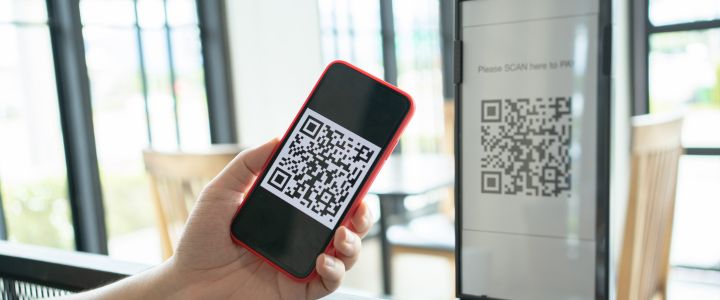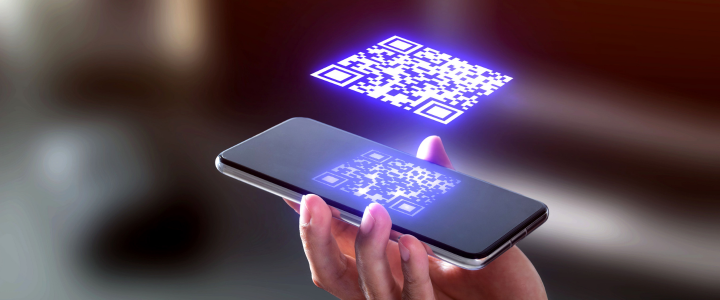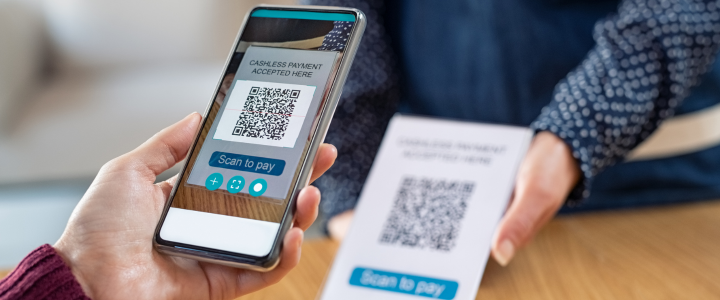Are you looking to take your marketing strategy to the next level? Look no further than the power of QR codes. QR codes, short for Quick Response codes, are compact, square-shaped codes that, when scanned, can provide users with instant access to information or websites.
In today's digital age, QR codes have become increasingly popular due to their ability to bridge the gap between physical and digital marketing. With the help of a QR code generator, you can effortlessly create customized codes that can be printed on various marketing materials such as business cards, brochures, billboards, and even product packaging.
By incorporating QR codes into your marketing campaigns, you can unlock a whole new level of engagement with your audience. Whether it's directing them to your website, sharing exclusive offers, or gathering valuable customer data, QR codes present endless possibilities for boosting brand awareness and driving conversions.
So, if you're ready to elevate your marketing strategy, don't overlook the power of QR codes. With the right QR code generator, you can create captivating and effective codes that will leave a lasting impression on your target audience.
How QR codes work
QR codes function by using a unique pattern of black squares on a white background. When scanned using a smartphone or QR code reader, the code is decoded, and the embedded information is instantly accessible to the user. This can include website URLs, contact information, app downloads, social media profiles, and much more.
The scanning process is quick and easy. Users simply open their preferred QR code scanning app, point their camera at the code, and within seconds, they are redirected to the designated destination. This seamless user experience makes QR codes an ideal tool for bridging the gap between offline and online marketing.
One of the key advantages of QR codes is their versatility. They can be printed on a wide range of materials, including paper, plastic, fabric, and even metal. This makes them suitable for various marketing applications, from print advertisements and product packaging to event tickets and business cards. The possibilities are virtually limitless.
Another important aspect to consider is that QR codes can be easily customized to align with your brand identity. You can incorporate your company's logo, colors, and even add a call-to-action to encourage users to scan the code. This level of customization ensures that your QR codes not only serve their function but also contribute to your overall brand strategy.
Benefits of using QR codes in marketing
When it comes to marketing, QR codes offer a multitude of benefits that can significantly enhance your campaigns. Here are just a few advantages that make QR codes an invaluable tool for marketers:
1. Enhanced User Engagement: QR codes provide a seamless and interactive way for users to engage with your brand. By scanning a QR code, users can access additional information, discounts, special offers, or even participate in contests and giveaways. This not only encourages engagement but also creates a sense of exclusivity and urgency, driving users to take action.
2. Increased Brand Awareness: By incorporating QR codes into your marketing materials, you can effectively extend your brand's reach. Whether it's through print ads, billboards, or even product packaging, QR codes serve as a direct link between the physical and digital worlds. This allows users to easily access your website, social media profiles, or other online channels, increasing brand exposure and awareness.
3. Valuable Customer Insights: QR codes can serve as a valuable tool for gathering data and insights about your target audience. By directing users to a customized landing page or survey, you can collect valuable information such as email addresses, preferences, and feedback. This data can then be used to tailor future marketing campaigns and improve customer experiences.
4. Cost-Effective Marketing: QR codes offer a cost-effective solution for marketers with limited budgets. Printing QR codes on marketing materials is relatively inexpensive, especially compared to traditional advertising methods. Furthermore, the digital nature of QR codes eliminates the need for physical distribution, saving both time and resources.
5. Measurable Results: One of the key advantages of QR codes is the ability to track and measure their performance. By utilizing analytics tools, you can gain insights into the number of scans, user demographics, and even the time and location of scans. This data allows you to evaluate the success of your QR code campaigns and make data-driven decisions for future marketing efforts.
In conclusion, QR codes provide numerous benefits that can significantly enhance your marketing strategy. From increased engagement and brand awareness to valuable customer insights and cost-effective marketing, QR codes offer a versatile and measurable solution for modern marketers.
QR code statistics and trends
As QR codes continue to gain popularity, it's important to stay up-to-date with the latest statistics and trends. Here are some key insights and trends that highlight the growing importance of QR codes in marketing:
1. Increasing Adoption: According to a study conducted by Juniper Research, it is estimated that QR code usage will exceed 5.3 billion scans by 2022. This indicates a significant increase in consumer adoption and demonstrates the growing relevance of QR codes in the digital landscape.
2. Mobile Scanning: With the widespread use of smartphones, QR code scanning has become more accessible than ever. In fact, statistics show that 76% of smartphone users have scanned a QR code within the past year. This highlights the importance of optimizing your QR code campaigns for mobile devices to ensure a seamless user experience.
3. Social Media Integration: Social media platforms have also embraced QR codes as a means of connecting online and offline experiences. Platforms such as Snapchat, Instagram, and Facebook allow users to scan QR codes to access profiles, pages, and even augmented reality experiences. Incorporating QR codes into your social media marketing efforts can significantly enhance user engagement and drive traffic to your online channels.
4. Contactless Solutions: The COVID-19 pandemic has accelerated the adoption of contactless solutions, with QR codes playing a crucial role. From contactless menus in restaurants to touchless payments at stores, QR codes offer a safe and convenient alternative to traditional methods. As consumers continue to prioritize hygiene and safety, integrating QR codes into your business operations can help provide a seamless and contactless experience for your customers.
5. Dynamic QR Codes: Traditionally, QR codes were static and could not be edited once generated. However, with the introduction of dynamic QR codes, marketers now have the ability to update the content and destination of their codes in real-time. This allows for greater flexibility and enables marketers to adapt their QR code campaigns based on changing circumstances or promotions.
As these statistics and trends indicate, QR codes are not only here to stay but are also evolving to meet the needs of modern marketers and consumers. By staying informed and leveraging these trends, you can ensure that your QR code campaigns remain relevant and effective.
Choosing a QR code generator
Now that you understand the benefits and trends of QR codes, it's time to choose the right QR code generator for your marketing needs. With numerous options available, it's essential to consider the following factors when making your selection:
1. Customization Options: Look for a QR code generator that offers a wide range of customization options. This includes the ability to add logos, colors, and calls-to-action to your codes. The more customizable the generator, the better you can align the QR codes with your brand identity and marketing goals.
2. Analytics and Tracking: Ensure that the QR code generator provides analytics and tracking features. This allows you to gain insights into the performance of your codes, including the number of scans, user demographics, and engagement metrics. Analyzing this data will help you optimize your campaigns and achieve better results.
3. Dynamic QR Codes: Consider a QR code generator that supports dynamic QR codes. Dynamic codes can be edited and updated in real-time, providing greater flexibility and adaptability. This is particularly useful when running time-sensitive promotions or campaigns that require frequent updates.
4. Scalability: If you plan to use QR codes across multiple marketing channels or campaigns, choose a generator that offers scalability. This means the ability to create and manage large quantities of codes efficiently. Look for features such as batch generation, code management, and easy integration with other marketing tools.
5. Ease of Use: The QR code generator should be intuitive and user-friendly, even for those without technical expertise. Look for a generator that offers a simple interface, easy code generation process, and clear instructions or tutorials. This will save you time and ensure a smooth experience when creating and implementing your QR code campaigns.
By considering these factors and evaluating different QR code generator options, you can select the one that best meets your marketing needs and objectives. Remember, the right generator will not only help you create captivating codes but also provide valuable insights to optimize your campaigns.
Best practices for using QR codes in marketing campaigns
Now that you have chosen a QR code generator and understand its key features, it's time to explore some best practices for using QR codes in your marketing campaigns. By following these guidelines, you can maximize the impact and effectiveness of your QR code campaigns:
1. Provide Value: Ensure that the content or destination of your QR codes provides value to the user. Whether it's exclusive discounts, additional information, or entertaining content, giving users a reason to scan your code will increase engagement and conversions.
2. Optimize for Mobile: With the majority of QR code scans happening on smartphones, it's crucial to optimize your landing pages or content for mobile devices. Make sure your website or destination is mobile-friendly, loads quickly, and provides a seamless user experience.
3. Test and Validate: Before launching your QR code campaigns, thoroughly test and validate your codes to ensure they work properly. Use different devices and QR code scanning apps to ensure compatibility and accuracy.
4. Prominent Placement: Ensure that your QR codes are prominently displayed on marketing materials, making it easy for users to scan them. Avoid cluttered designs and ensure that the codes are large enough to be scanned from a reasonable distance.
5. Call-to-Action: Include a clear call-to-action alongside your QR codes to encourage users to scan them. Use phrases such as "Scan to learn more," "Unlock exclusive offers," or "Discover the hidden content."
6. Monitor and Optimize: Continuously monitor the performance of your QR code campaigns and make data-driven decisions to optimize them. Analyze scan data, user behavior, and conversion rates to identify areas for improvement and refine your strategy.
By following these best practices, you can ensure that your QR code campaigns are effective, engaging, and drive meaningful results for your marketing efforts.
Creative ways to use QR codes in marketing
QR codes offer endless creative possibilities for marketers. Here are some unique and innovative ways to incorporate QR codes into your marketing campaigns:
1. Interactive Product Packaging: Print QR codes on product packaging to provide users with additional product information, tutorials, or even personalized messages. This creates an interactive and memorable experience for customers and enhances brand loyalty.
2. Scavenger Hunts: Create a QR code scavenger hunt as part of a promotional campaign. Place QR codes in different locations, each leading to the next clue or a hidden offer. This encourages users to engage with your brand and increases excitement and participation.
3. Augmented Reality Experiences: Combine QR codes with augmented reality (AR) to create immersive experiences. Users can scan a QR code to unlock AR content, such as virtual try-on experiences, interactive games, or 3D product demonstrations.
4. QR Code Business Cards: Replace traditional business cards with QR code business cards. The QR code can lead to your contact information, social media profiles, or a personalized introduction video. This modern approach leaves a lasting impression on potential clients or partners.
5. Instant Feedback Surveys: Use QR codes to gather instant feedback from customers. Place QR codes on receipts, product packaging, or in-store displays, leading users to a quick survey or feedback form. This allows you to collect valuable insights and improve your products or services.
6. Event Registration: Simplify event registration by utilizing QR codes. Attendees can scan a QR code on invitations or event posters to quickly register and receive event details. This eliminates the need for manual registration forms and improves the overall attendee experience.
By thinking outside the box and getting creative, you can leverage the power of QR codes to create memorable and engaging marketing campaigns. Experiment with different ideas, test the results, and refine your approach based on user feedback and data.
Case studies of successful QR code marketing campaigns
To further illustrate the effectiveness of QR codes in marketing, let's take a look at some successful case studies:
1. Macy's: Backstage Pass Campaign
Macy's, a renowned department store, launched the "Backstage Pass" campaign, allowing customers to scan QR codes placed on store displays and mannequins. Sc
Conclusion: Harnessing the potential of QR codes for your business
1. Nike's QR Code Campaign
Nike, one of the world's leading sports brands, utilized QR codes to enhance their marketing efforts and provide users with a unique experience. In one of their campaigns, Nike placed QR codes on their shoeboxes, allowing customers to scan the code and access exclusive content related to the product they purchased. This content ranged from workout videos featuring professional athletes to personalized training plans tailored to the customer's fitness goals. By leveraging QR codes, Nike not only enhanced their customers' experience but also strengthened their brand loyalty.
2. Starbucks' QR Code Payment System
Starbucks revolutionized the coffee industry by introducing a QR code payment system through their mobile app. Customers can load their Starbucks cards onto the app, and when it's time to pay, they simply scan the QR code displayed on the app at the register. This convenient and contactless payment method not only streamlined the checkout process but also allowed Starbucks to collect valuable customer data. By analyzing the purchasing patterns of their customers, Starbucks could offer personalized promotions and incentives, further enhancing the overall customer experience.
3. Coca-Cola's QR Code Contest
Coca-Cola, a global beverage giant, utilized QR codes to engage and reward their customers through a QR code contest. The company printed QR codes on their product packaging, prompting customers to scan the code and enter the contest for a chance to win exciting prizes. This interactive marketing campaign not only generated buzz around Coca-Cola but also allowed them to collect valuable customer data for future marketing initiatives. By incorporating QR codes into their packaging, Coca-Cola was able to create a seamless connection between their physical products and their digital marketing efforts.



